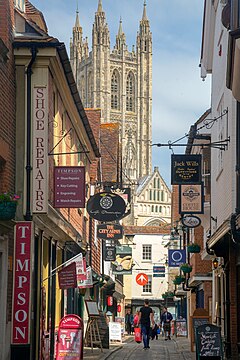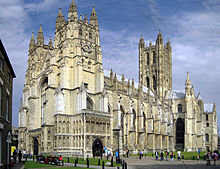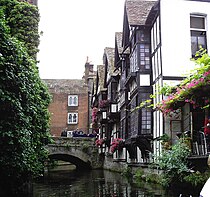Canterbury
| City of Canterbury | ||
|---|---|---|
| Butchery Lane | ||
| Coordinates | 51 ° 17 ′ N , 1 ° 5 ′ E | |
| OS National Grid | TR145575 | |
|
|
||
| Residents | 62,767 (as of 2017) | |
| surface | 24 km² (9.27 mi² ) | |
| Population density: | 2615 inhabitants per km² | |
| language | English | |
| administration | ||
| Post town | CANTERBURY | |
| ZIP code section | CT1-CT4 | |
| prefix | 01227 | |
| Part of the country | England | |
| region | South East England | |
| Website: Canterbury City Council | ||
Canterbury [ kæntəbəɹɪ ] (from Old English Cantwaraburig for "castle (or city, town) of the people of Kent", lat . Cantuaria , dated the Germans Kanter Mountain , Kanter castle or Kantelberg ) is a British university town with 62,767 inhabitants (2017). It is located on the River Stour in the county of Kent in south-east England and is the seat of the Archbishop of Canterbury and the center of the Anglican Church of England.
history
According to legend, Canterbury is said to be after 900 BC By Rudilibas and called Caerther or Caerkent (city of Kent) by the ancient British . From AD 43, the Roman Durovernum Cantiacorum (Roman: duro = " fort ", verno = " swamp "), which developed into an administrative center and owned the largest Roman theater in Britain, was built in its place; from 200 AD the city was surrounded by a city wall. Æthelberht of Kent , who ruled from AD 568, made Canterbury his residence and named it Cantwarabyrig .
After the Anglo-Saxons converted to Christianity, the city became the seat of the Archbishop-Primate , the spiritual leader of the Church of England and the Anglican Communion . The Archbishops of Canterbury have been appointed by the English King (later British King ) since Henry VIII's break with Rome .
Archbishops
The Apostle of the Anglo-Saxons, Augustine of Canterbury , also known as Austin, was the first Archbishop of Canterbury. He was sent to King Æthelberht by Pope Gregory I in 597, accompanied by Lawrence of Canterbury , who later became the second Archbishop.
Augustine had an old church in Canterbury rebuilt and rededicated as his cathedral and founded a monastery for it. A second monastery outside the city walls was dedicated to St. Peter and St. Paul . Later, in 978, the monastery was consecrated to Augustine, who has now been canonized.
The Italian philosopher and theologian Anselm of Canterbury became Archbishop of Canterbury in 1093, but had to go into exile twice because he fell out with William II and Henry I over the question of lay investment .
With Justin Welby the 105th archbishop was ordained in unbroken succession, 2013. He is the successor to Rowan Williams , who took office in 2002.
cathedral
The Canterbury Cathedral ( Christ Church Cathedral ) is built in the form of an archbishop's double cross and has east-west length of 160 meters and in its two transepts a width of 48 and 40 meters. The oldest part is the crypt , built around 1070 . The church is the burial place of King Henry IV of England and Edward of Woodstock , the "Black Prince". Above all, it became famous through the murder of Thomas Becket in 1170. His long-lost shrine was the destination of thousands of pilgrims until the Reformation , including Geoffrey Chaucer , who wrote his Canterbury Tales in 1387.
Canterbury in literature
The murder of Thomas Becket is featured in the dramas by George Darley (1840), Alfred Tennyson (1884) and Jean Anouilh (1959), and in TS Eliot's play Murder in the Cathedral (1935), which premiered at Chapter House and in Ken Follett's novel The Pillars of the Earth .
The stories of the Canterbury Tales (German: "Canterbury stories") by the medieval poet Geoffrey Chaucer are integrated into a framework story that is about a group of pilgrims on their way from London to Canterbury to the tomb of Thomas Becket. The themes of the stories vary and include courtly love, betrayal, and greed. The genres also vary, there are romances , Breton Lai (short rhythmic tales), sermons and fables . Here is an example from the 14th century Middle English text:

- Bifil that in that seson, on a day,
- In Southwerk at the Tabard as I lay
- Redy to turn on my pilgrymage
- To Caunterbury with ful devout corage,
- At nyght was come into that hostelrye
- Wel nyne and twenty in a compaignye
- Of sondry folk, by aventure yfalle
- In felaweshipe, and pilgrimes were they alle,
- That toward Caunterbury wolden ryde.
Urban development
Canterbury developed into a significant settlement in Roman times as the aforementioned Durovernum Cantiacorum . After the Christianization of Kent , some early Roman churches were prepared for use again. B. St. Martin and the church then on the site of the current cathedral. Since that time Canterbury has been the center of the Church in England and an attraction for many visitors; after the murder of Thomas Becket, these were mainly pilgrims. In the 12th century Canterbury became the second largest mint in England after London. In the 16th century, thanks to the introduction of weaving by the Huguenots, who came as religious refugees from the mainland, an economic boom began. In 1888, the city was granted county rights, although until then it had hardly been affected by the Industrial Revolution and the number of inhabitants had increased only slightly.
Cityscape and landmarks
The city remained largely unchanged for a long time, but was badly damaged in the Second World War by the German Air Force in the " Baedeker retaliation attacks" on culturally important cities in England in 1942, especially on June 1st. Since then, Canterbury has grown into a modern city and a major shopping center, with plenty of leisure activities, good transport links and a variety of accommodation options. Because many historical buildings have been preserved, the medieval character of the town center has been preserved. In addition to the cathedral, the many other old church buildings in the city are also remarkable. Worth mentioning here are u. a. Greyfriars , St Martin's Church and St. Dunstan's Church .
Much of the city wall is intact; Of the six old gates only one remains, the Westgate, from the time of Richard II ; it now houses a museum. The historic weavers' houses line the river Stour, and further downstream are the Blackfriars and Greyfriars monasteries from the 13th century. Canterbury offers a variety of other historical attractions such as the keep of the former Norman Canterbury Castle or the Norman staircase of the King's School . Some of them have served as inspiration to famous poets and writers. Christopher Marlowe was born in Canterbury and baptized in St. George. Despite his closer ties to Rochester and Broadstairs , Charles Dickens chose Canterbury as the setting for his novel David Copperfield .
In addition to the Canterbury Cathedral is the St Martin's Church World Heritage Site.
Educational institutions
The city's educational institutions include the University of Kent , Canterbury Christ Church University (founded in 1962), the University for the Creative Arts , Chaucer College , a graduate school for Japanese students, and the Franciscan International Study Center , a school for the Order the Franciscan . There was also St. Augustine's College , a theological seminary of the Anglican Church, from 1848 to 1976 . There is also Kent College on Whitstable Road, which is staffed with international students.
The King's School was founded in 597 by Saint Augustine of Canterbury and is the oldest surviving school in the world.
Museums
The Canterbury Heritage Museum provides information about the city's history in impressive presentations, while the Canterbury Tales Museum reports on Chaucer and his time. In Roman Museum is a mosaic in situ preserved. In the medieval west gate there is a small military history museum, which shows, among other things, German booty from the two world wars.
Transport links
Canterbury has two train stations and is on the A2 expressway to London. The city is connected to the Eurostar via the rail network, which stops in Ashford (25 kilometers away). From there there are direct connections to London-St Pancras , Paris and Brussels . The road network connects Canterbury with mainland Europe via the car ferries from neighboring Dover . From 1830, the Canterbury – Whitstable line was a direct rail link from the port city of Whitstable, 10 kilometers to the north, for 120 years .
Population development
| 1801 | 9,500 |
| 1861 | 16,700 |
| 1921 | 18,900 |
| 1961 | 30,408 |
| 2001 | 42,264 |
| 2004 | 44,000 |
| 2011 | 55,240 |
In 2001, 94 percent of the population identified themselves as white. No other group has more than two percent of the population.
The approximately 42,000 inhabitants on an area of 23.54 km² result in a population density of 1,795 people per square kilometer.
Town twinning
Personalities
sons and daughters of the town
- Christopher Marlowe (1564–1593), poet
- Richard Harris Barham (1788-1845), writer
- Thomas Sidney Cooper (1803-1902), painter
- Maxwell Tylden Masters (1833-1907), physician and botanist
- Edmund Caldwell (1852–1930), painter, illustrator, sculptor and etcher
- Herbert Austin Fricker (1868–1943), Canadian choir director, organist, music teacher and composer
- William Sealy Gosset (1876-1937), statistician
- Ralph Eastwood (1890–1959), Lieutenant General and Governor of Gibraltar
- Jack Gwillim (1909-2001), actor
- Anna Reynolds (1930-2014), mezzo-soprano
- Hugh Hopper (1945–2009), bassist and composer
- Roger Turner (* 1946), jazz drummer
- Trevor Pinnock (* 1946), conductor and harpsichordist
- Paul Roland (* 1959), musician, writer and journalist
- Orlando Bloom (born 1977), actor
- Joseph McManners (* 1992), singer and actor
- Jack Scanlon (born 1998), actor
- Sam McCallum (* 2000), soccer player
Personalities who have worked in this city
- Alexander Minto Hughes (1945–1998), British reggae and ska musician, known as Judge Dread
- Ian Fleming (1908–1964), British writer
literature
- Bamberik Gascoigne: Encyclopedia of Britain . BCA, London, New York, Sydney, Toronto 1993, ISBN 0-333-54764-0 , p. 112.
- Meyer's Encyclopedic Lexicon . Bibliographisches Institut, Mannheim / Vienna / Zurich 1972, Volume 5, pp. 306f.
- Dorothy Eagle (Ed.): The Oxford Illustrated Literary Guide to Great Britain and England. BCA and Oxford University Press, 1992, p. 43.
Individual evidence
- ↑ a b City Population
- ↑ Official website (accessed December 30, 2009)
- ↑ Vladimir: Sister Cities
Web links
- Canterbury Tourism
- Canterbury Cathedral
- Illustration of the city 1588 in Civitates orbis terrarum by Georg Braun
← Previous location: beginning of the trail | Canterbury | Next town: Dover 32.2 km →
![]() Canterbury |
Dover |
Calais |
Wissant |
Guînes |
Licques |
Wisques |
Thérouanne |
Auchy-au-Bois |
Bruay-la-Buissière |
Arras |
Bapaume |
Peronne |
Doingt |
Seraucourt-le-Grand |
Tergnier |
Laon |
Bouconville-Vauclair |
Corbeny |
Hermonville |
Reims |
Trépail |
Châlons-en-Champagne |
Cool |
Brienne-le-Château |
Bar-sur-Aube |
Châteauvillain |
Blessonville |
Langres |
Humes-Jorquenay |
Coublanc |
Grenant |
Dampierre-sur-Salon |
Savoyeux |
Seveux |
Gy |
Cussey-sur-l'Ognon |
Besançon |
Étalans |
Chasnans |
Nods |
Ouhans |
Pontarlier |
Yverdon-les-Bains |
Orbe |
Lausanne |
Cully |
Vevey |
Montreux |
Villeneuve |
Aigle |
Saint-Maurice |
Martigny |
Orsières |
Bourg-Saint-Pierre |
Great St. Bernhard |
Saint-Rhémy-en-Bosses |
Saint-Oyen |
Étroubles |
Gignod |
Aosta |
Saint-Christophe |
Quart |
Nut |
Verrayes |
Chambave |
Saint-Denis |
Châtillon |
Saint-Vincent |
Montjovet |
Issogne |
Verrès |
Arnad |
Hône |
Bard |
Donnas |
Pont-Saint-Martin |
Carema |
Settimo Vittone |
Borgofranco d'Ivrea |
Montalto Dora |
Ivrea |
Cascinette d'Ivrea |
Burolo |
Bollengo |
Palazzo Canavese |
Piverone |
Azeglio |
Viverone |
Roppolo |
Cavaglià |
Santhià |
San Germano Vercellese |
Olcenengo |
Salasco |
Sali Vercellese |
Vercelli |
Palestro |
Robbio |
Nicorvo |
Castelnovetto |
Albonese |
Mortara |
Cergnago |
Tromello |
Garlasco |
Gropello Cairoli |
Villanova d'Ardenghi |
Zerbolò |
Carbonara al Ticino |
Pavia |
Valle Salimbene |
Linarolo |
Belgioioso |
Torre de 'Negri |
Costa de 'Nobili |
Santa Cristina e Bissone |
Miradolo Terme |
Chignolo Po |
San Colombano al Lambro |
Orio Litta |
Senna Lodigiana |
Calendasco |
Rottofreno |
Piacenza |
Podenzano |
San Giorgio Piacentino |
Pontenure |
Carpaneto Piacentino |
Cadeo |
Fiorenzuola d'Arda |
Chiaravalle della Colomba |
Alseno |
Busseto |
Fidenza |
Costamezzana |
Noceto |
Medesano |
Fornovo di Taro |
Terenzo |
Berceto |
Pontremoli |
Filattiera |
Villafranca in Lunigiana |
Bagnone |
Licciana Nardi |
Aulla |
Santo Stefano di Magra |
Sarzana |
Castelnuovo Magra |
Ortonovo |
Luni |
Fosdinovo |
Carrara |
Massa |
Montignoso |
Seravezza |
Pietrasanta |
Camaiore |
Lucca |
Capannori |
Porcari |
Montecarlo |
Altopascio |
Castelfranco di Sotto |
Santa Croce sull'Arno |
Ponte a Cappiano |
Fucecchio |
San Miniato |
Castelfiorentino |
Coiano |
Montaione |
Gambassi Terme |
San Gimignano |
Colle di Val d'Elsa |
Badia a Isola |
Monteriggioni |
Siena |
Monteroni d'Arbia |
Ponte d'Arbia |
Buonconvento |
Montalcino |
Torrenieri |
San Quirico d'Orcia |
Bagno Vignoni |
Castiglione d'Orcia |
Radicofani |
San Casciano dei Bagni |
Abbadia San Salvatore |
Piancastagnaio |
Ponte a Rigo |
Proceno |
Acquapendente |
Grotte di Castro |
San Lorenzo Nuovo |
Bolsena |
Montefiascone |
Viterbo |
Ronciglione |
Vetralla |
Capranica |
Sutri |
Monterosi |
Nepi |
Mazzano Romano |
Campagnano di Roma |
Formello |
La Storta |
Rome
Canterbury |
Dover |
Calais |
Wissant |
Guînes |
Licques |
Wisques |
Thérouanne |
Auchy-au-Bois |
Bruay-la-Buissière |
Arras |
Bapaume |
Peronne |
Doingt |
Seraucourt-le-Grand |
Tergnier |
Laon |
Bouconville-Vauclair |
Corbeny |
Hermonville |
Reims |
Trépail |
Châlons-en-Champagne |
Cool |
Brienne-le-Château |
Bar-sur-Aube |
Châteauvillain |
Blessonville |
Langres |
Humes-Jorquenay |
Coublanc |
Grenant |
Dampierre-sur-Salon |
Savoyeux |
Seveux |
Gy |
Cussey-sur-l'Ognon |
Besançon |
Étalans |
Chasnans |
Nods |
Ouhans |
Pontarlier |
Yverdon-les-Bains |
Orbe |
Lausanne |
Cully |
Vevey |
Montreux |
Villeneuve |
Aigle |
Saint-Maurice |
Martigny |
Orsières |
Bourg-Saint-Pierre |
Great St. Bernhard |
Saint-Rhémy-en-Bosses |
Saint-Oyen |
Étroubles |
Gignod |
Aosta |
Saint-Christophe |
Quart |
Nut |
Verrayes |
Chambave |
Saint-Denis |
Châtillon |
Saint-Vincent |
Montjovet |
Issogne |
Verrès |
Arnad |
Hône |
Bard |
Donnas |
Pont-Saint-Martin |
Carema |
Settimo Vittone |
Borgofranco d'Ivrea |
Montalto Dora |
Ivrea |
Cascinette d'Ivrea |
Burolo |
Bollengo |
Palazzo Canavese |
Piverone |
Azeglio |
Viverone |
Roppolo |
Cavaglià |
Santhià |
San Germano Vercellese |
Olcenengo |
Salasco |
Sali Vercellese |
Vercelli |
Palestro |
Robbio |
Nicorvo |
Castelnovetto |
Albonese |
Mortara |
Cergnago |
Tromello |
Garlasco |
Gropello Cairoli |
Villanova d'Ardenghi |
Zerbolò |
Carbonara al Ticino |
Pavia |
Valle Salimbene |
Linarolo |
Belgioioso |
Torre de 'Negri |
Costa de 'Nobili |
Santa Cristina e Bissone |
Miradolo Terme |
Chignolo Po |
San Colombano al Lambro |
Orio Litta |
Senna Lodigiana |
Calendasco |
Rottofreno |
Piacenza |
Podenzano |
San Giorgio Piacentino |
Pontenure |
Carpaneto Piacentino |
Cadeo |
Fiorenzuola d'Arda |
Chiaravalle della Colomba |
Alseno |
Busseto |
Fidenza |
Costamezzana |
Noceto |
Medesano |
Fornovo di Taro |
Terenzo |
Berceto |
Pontremoli |
Filattiera |
Villafranca in Lunigiana |
Bagnone |
Licciana Nardi |
Aulla |
Santo Stefano di Magra |
Sarzana |
Castelnuovo Magra |
Ortonovo |
Luni |
Fosdinovo |
Carrara |
Massa |
Montignoso |
Seravezza |
Pietrasanta |
Camaiore |
Lucca |
Capannori |
Porcari |
Montecarlo |
Altopascio |
Castelfranco di Sotto |
Santa Croce sull'Arno |
Ponte a Cappiano |
Fucecchio |
San Miniato |
Castelfiorentino |
Coiano |
Montaione |
Gambassi Terme |
San Gimignano |
Colle di Val d'Elsa |
Badia a Isola |
Monteriggioni |
Siena |
Monteroni d'Arbia |
Ponte d'Arbia |
Buonconvento |
Montalcino |
Torrenieri |
San Quirico d'Orcia |
Bagno Vignoni |
Castiglione d'Orcia |
Radicofani |
San Casciano dei Bagni |
Abbadia San Salvatore |
Piancastagnaio |
Ponte a Rigo |
Proceno |
Acquapendente |
Grotte di Castro |
San Lorenzo Nuovo |
Bolsena |
Montefiascone |
Viterbo |
Ronciglione |
Vetralla |
Capranica |
Sutri |
Monterosi |
Nepi |
Mazzano Romano |
Campagnano di Roma |
Formello |
La Storta |
Rome![]()
![]()
![]()




